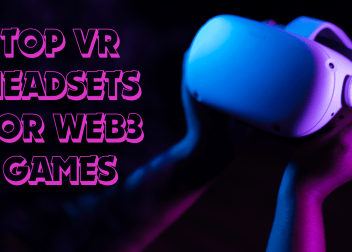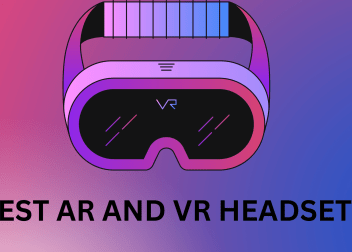Buy Mobile VR That Fits You The Best!
BUY MOBILE VR HEADSETS:
| Meta Quest 2: | Pros:
|
Cons:
|
| Nintendo Labo VR Kit:
|
Pros:
|
Cons:
|
| Playstation VR: | Pros:
|
Cons:
|
| Oculus Rift: | Pros:
|
Cons:
|
Meta Quest 2:
The Meta Quest 2, formerly known as the Oculus Quest 2, stands out as a top-tier VR headset with upgraded specs and a sleek design, cementing its position as the best all-around device in the VR landscape. Priced at $249 for the 128GB variant, the headset offers an enticing blend of affordability and impressive features.
Boasting a streamlined and comfortable design, the Meta Quest 2 enhances the virtual reality experience with intuitive controllers and a robust library of games and applications. Its standalone design eliminates the need for tethering to a PC, console, or phone, allowing users to indulge in immersive VR escapades effortlessly. While it can be connected to a PC for Steam VR games, it operates seamlessly without this requirement.
The headset’s noteworthy features include a Qualcomm Snapdragon XR2 chipset, a display resolution of 1832 x 1920 per eye, and storage options of 64GB or 256GB. With 6GB of RAM, the Meta Quest 2 delivers a commendable performance, though its battery life is rated at 2-3 hours. The device weighs 1.1 pounds and measures 7.5 x 4 x 5.2 inches, ensuring a balance between comfort and functionality.
Nintendo labo vr kit
Nintendo’s Labo VR Kit invites users into a whimsical world of cardboard creations, offering an accessible entry point to the realm of virtual reality (VR). The $80 kit includes six primary “Toy-Con” projects: a Camera, a Bird, a Wind Pedal, an Elephant, a Blaster, and the VR Headset itself. Alternatively, a $40 Starter Set featuring only the Headset and Blaster is available, with the option to purchase additional projects separately.
Labo VR’s charm lies in its unique approach to VR construction. The included software estimates completion times for each project, ranging from a quick 30 minutes to a more substantial three hours for the Blaster. Building all six projects can take six to 11 hours, providing a creative and engaging experience. The downside, however, is that Labo creations are not designed to be disassembled, posing a storage challenge for those with limited space.
While the Labo VR Kit may seem deceptively simple with its cardboard headset and quirky add-ons, it serves as a surprisingly robust introduction to VR. Despite a display resolution and framerate below dedicated VR headsets, the kit offers a variety of entertaining games and tools, making it an enjoyable experience in short bursts.
The building process, a hallmark of Nintendo’s Labo series, remains a mixed bag. While constructing sturdy and well-engineered accessories can be satisfying, the sluggish instruction videos and numerous steps may turn the building aspect into a chore.
The real star of Labo VR, however, is the VR experience itself. Using plastic lenses, Nintendo creates a virtual world by inserting the Switch into the cardboard headset. The absence of a head strap requires users to hold the headset, leading to occasional breaks—something Labo VR encourages. Despite visual quality limitations and the screen door effect, Labo VR immerses users in Nintendo’s vibrant worlds.
Playstation VR:
PlayStation VR (PSVR) remains an affordable gateway into virtual reality, offering a commendable experience without the need for an expensive PC gaming rig. Priced at $249.97 for the PS4 variant, this VR headset provides near PC-quality performance. Also, it boasts a diverse selection of games, making it an attractive option for console gamers.
While the PSVR may not match the visual crispness of high-end competitors, its accessibility and recent price reduction enhance its appeal. The headset relies on a PS4 instead of a high-powered gaming PC. It is definately an enticing alternative for those on a budget.
Despite its age, the PSVR continues to hold its own in the VR market. As of January 2020, Sony reported selling over five million PSVR systems, with 21.9 million VR games and apps accompanying the headset. The device has become a game-changer, and even with the impending release of the PSVR2, Sony ensures compatibility by providing a free adapter for the original PSVR.
The original PSVR, launched nearly six years ago, has seen improvements, with a revised headset addressing issues like HDR-passthrough, enhanced audio, and improved comfort. The device features a 920 x RGB x 1080 OLED display capable of handling 1080p games at either 90Hz or 120Hz, depending on the VR application. Sony boasts a response rate of approximately 18ms, ensuring minimal latency.
Oculus Rift:
The Oculus Rift, launched in 2016, was heralded as a potential game-changer in the world of gaming and virtual reality (VR). While it may not have fully realized the vision of being the ‘future of entertainment,’ it has evolved over the years, presenting an optimistic outlook for the future.
The Oculus Rift’s wired connection to a PC is crucial for delivering a powerful VR experience, requiring a high-end gaming PC with specifications like an Intel Core i3-6100 or equivalent processor, 8GB of RAM, and a NVIDIA GTX 960 or AMD Radeon 290 video card. The initial minimum requirements included a higher-end Intel Core i5 4590, showcasing a later adjustment for a more affordable option.
The headset’s price has seen reductions over time, making it more accessible. While there isn’t a fixed price, third-party sellers offer the Oculus Rift, including the headset, two sensors, and the Touch Controllers, for around $399 / £399 / AU$399 at the time of writing. This positions it competitively against newer options like the Oculus Quest 2 and the Oculus Rift S.
In terms of functionality, the Oculus Rift offers a superior experience compared to PlayStation VR, Google Cardboard, and Samsung Gear VR, thanks to its wired connection and sophisticated hardware. Although not as immersive as the HTC Vive, it provides an engaging VR experience. The headset has undergone several iterations, with the latest version being significantly improved in terms of setup ease and technical requirements.
Using virtual reality with the Oculus Rift is an indescribable experience, transporting users to different worlds and providing a sense of presence. The product, born out of a Kickstarter project that gained $2 million in funding before being acquired by Facebook, has undergone continuous development since its inception in 2012.
Conclusion:
In the ever-evolving landscape of virtual reality, mobile VR headsets have emerged as versatile and accessible gateways into digital experiences. The Meta Quest 2 stands out with its sleek design, impressive game library, and competitive pricing. All of these make it a top choice for those stepping into VR. On the other hand, the Labo VR Kit combines cardboard construction with a variety of entertaining mini-games. PlayStation VR caters to console gamers, providing an affordable entry into quality virtual reality. Each of these mobile VR headsets brings its own strengths to the table, catering to different preferences and budgets. As technology advances, these headsets continue to redefine the way users interact with virtual worlds. They are surely making VR more accessible and engaging for a broader audience.






